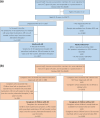Observational Study of Corticosteroid Phobia Using the TOPICOP Score among Adults and Caregivers of Children with Atopic Dermatitis in Japan
- PMID: 40379942
- PMCID: PMC12126417
- DOI: 10.1007/s13555-025-01439-6
Observational Study of Corticosteroid Phobia Using the TOPICOP Score among Adults and Caregivers of Children with Atopic Dermatitis in Japan
Abstract
Introduction: Topical corticosteroid (TCS) phobia, which tends to interfere with the continuation of TCS treatment for atopic dermatitis (AD), has not been elucidated in Japan using the topical corticosteroid phobia (TOPICOP) scale. We aimed to clarify TCS phobia among patients with AD in Japan and evaluate its relationship with AD conditions.
Methods: This observational study, using the database of health receipt (between October 2021 and October 2022) and online questionnaire (conducted in October 2022) data, included adult respondents with and without AD and caregivers who responded to the questionnaire about their children aged ≤ 18 years, with and without AD. The TOPICOP scores measuring TCS phobia were summarized and compared according to AD severity, consultation with a doctor, and presence of AD using an analysis of covariance (ANCOVA) model (covariates: sex and age).
Results: In this study, 1507 adults with AD and 525 caregivers of children with AD were included. Among adults with AD, the mean TOPICOP score (± standard deviation) was 42.5 ± 18.9, while it was 41.7 ± 18.6 among caregivers of children with AD. Of the three TOPICOP domains (knowledge and beliefs, fears, and behaviors), the fear domain questions showed the highest percentage of agreement in both adults and caregivers of children with AD. In the ANCOVA models, the scores did not differ significantly according to AD severity, consultation with a doctor, or the presence of AD in adults and caregivers but significantly differed by sex and age (both p < 0.001) in adults.
Conclusion: We obtained the latest TOPICOP scores that were independent of AD conditions in Japan. Most adults and caregivers of children with AD had TCS phobia, regardless of the AD conditions. Periodic education may be required for a wide range of patients and caregivers to ease TCS phobia and enable them to continue appropriate AD treatment.
Keywords: Atopic dermatitis; Japan; Patient reported outcome measures; Topical corticosteroid phobia; Topical corticosteroid phobia (TOPICOP) scale.
© 2025. The Author(s).
Conflict of interest statement
Declarations. Conflict of Interest: Takeshi Nakahara has received consulting fees and/or speaker honoraria from Mitsubishi Tanabe Pharma, Taiho Pharmaceutical, Torii Pharmaceutical, Maruho, Sanofi, AbbVie, Eli Lilly Japan, Sun Pharma and Otsuka Pharmaceutical. Hiroyuki Murota has received consulting fees and/or speaker honoraria from Maruho Co., Ltd., Sanofi K.K., Pfizer Japan Inc., Torii Pharmaceutical Co., Ltd., Eli Lilly Japan K.K., AbbVie GK, and Otsuka Pharmaceutical Co., Ltd. Shinichi Noto has received speaker honoraria from Otsuka Pharmaceutical. Miyuki Matsukawa, Rikiya Toda, Yasuhito Konishi, and Daisaku Michikami are employees of Otsuka Pharmaceutical Co., Ltd. Ethical Approval: This study was approved on October 21, 2022 by the Research Ethics Committee of Research and Development Division, Otsuka Pharmaceutical Co., Ltd. (approval no: 221013). The dataset used in this study was purchased from the DeSC. We have permission to use this database for the purposes of the research presented in this study. As we used secondary anonymized data, no individual-level informed consent was obtained. The survey was conducted in accordance with the Ethical Guidelines for Medical and Biological Research Involving Human Subjects in Japan and Declaration of Helsinki.
Figures





Similar articles
-
Topical corticosteroid phobia among caretakers of children with atopic dermatitis: A cross-sectional study using TOPICOP in Japan.Pediatr Dermatol. 2019 May;36(3):311-316. doi: 10.1111/pde.13784. Epub 2019 Mar 18. Pediatr Dermatol. 2019. PMID: 30882946
-
Topical Corticosteroid Phobia Among Parents of Children with Atopic Dermatitis (Eczema)- A Cross-Sectional Study.Patient Prefer Adherence. 2023 Nov 2;17:2761-2772. doi: 10.2147/PPA.S431719. eCollection 2023. Patient Prefer Adherence. 2023. PMID: 37936715 Free PMC article.
-
Topical corticosteroid phobia in atopic dermatitis: International feasibility study of the TOPICOP score.Allergy. 2017 Nov;72(11):1713-1719. doi: 10.1111/all.13189. Epub 2017 May 22. Allergy. 2017. PMID: 28439896
-
Treatment Adherence in Pediatric Atopic Dermatitis: A Systematic Review.Pediatr Dermatol. 2024 Nov-Dec;41(6):1077-1090. doi: 10.1111/pde.15771. Epub 2024 Oct 4. Pediatr Dermatol. 2024. PMID: 39364670
-
Topical Steroid Withdrawal: An Emerging Challenge in the Treatment of Atopic Dermatitis.J Paediatr Child Health. 2025 Apr;61(4):545-548. doi: 10.1111/jpc.70018. Epub 2025 Feb 11. J Paediatr Child Health. 2025. PMID: 39935098 Review.
References
-
- Tian J, Zhang D, Yang Y, et al. Global epidemiology of atopic dermatitis: a comprehensive systematic analysis and modelling study. Br J Dermatol. 2023;190:55–61. - PubMed
-
- Williams H, Robertson C, Stewart A, et al. Worldwide variations in the prevalence of symptoms of atopic eczema in the International Study of Asthma and Allergies in Childhood. J Allergy Clin Immunol. 1999;103:125–38. - PubMed
-
- Morita E. Analysis and organization of data on the actual number of patients with atopic dermatitis, causes, and aggravating factors, FY2001 Ministry of Health, Labour and Welfare Research Grant: Research report on immunology/allergy diseases. 2002:184–6.
-
- Mortz CG, Andersen KE, Dellgren C, Barington T, Bindslev-Jensen C. Atopic dermatitis from adolescence to adulthood in the TOACS cohort: prevalence, persistence and comorbidities. Allergy. 2015;70:836–45. - PubMed
-
- Bannister MJ, Freeman S. Adult-onset atopic dermatitis. Australas J Dermatol. 2000;41:225–8. - PubMed
LinkOut - more resources
Full Text Sources

